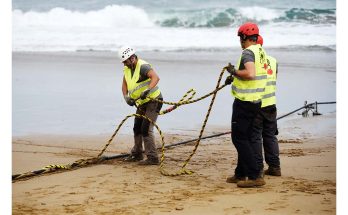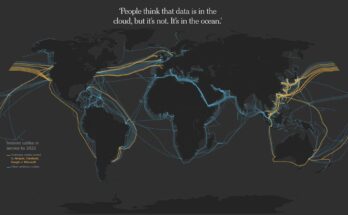“How Google Is Cramming More Data Into Its New Atlantic Cable: Google says its planned Dunant cable from Virginia to France will transmit 250 terabits per second, enough to zap the Library of Congress through it three times a second.”
WIRED, May 5, 2019
Business
By Klint Finley
Google says the fiber-optic cable it’s building across the Atlantic Ocean will be the fastest of its kind.
Google says the fiber-optic cable it’s building across the Atlantic Ocean will be the fastest of its kind. When the cable goes live next year, the company estimates it will transmit around 250 terabits per second, fast enough to zap all the contents of the Library of Congress from Virginia to France three times every second. That’s about 56 percent faster than Facebook and Microsoft’s Marea cable, which can transmit about 160 terabits per second between Virginia and Spain.
Fiber-optic networks work by sending light over thin strands of glass. Fiber-optic cables, which are about the diameter of a garden hose, enclose multiple pairs of these fibers. Google’s new cable is so fast because it carries more fiber pairs. Today, most long-distance undersea cables contain six or eight fiber-optic pairs. Google said Friday that its new cable, dubbed Dunant, is expected to be the first to include 12 pairs, thanks to new technology developed by Google and SubCom, which designs, manufactures, and deploys undersea cables.
Dunant might not be the fastest for long: Japanese tech giant NEC says it has technology that will enable long-distance undersea cables with 16 fiber-optic pairs. And Vijay Vusirikala, head of network architecture and optical engineering at Google, says the company is already contemplating 24-pair cables.
The surge in intercontinental cables, and their increasing capacity, reflect continual growth in internet traffic. They enable activists to livestream protests to distant countries, help companies buy and sell products around the world, and facilitate international romances. “Many people still believe international telecommunications are conducted by satellite,” says NEC executive Atsushi Kuwahara. “That was true in 1980, but nowadays, 99 percent of international telecommunications is submarine.”
So much capacity is being added that, for the moment, it’s outstripping demand. Animations featured in a recent New York Times article illustrated the exploding number of undersea cables since 1989. That growth is continuing. Alan Mauldin of the research firm Telegeography says only about 30 percent of the potential capacity of major undersea cable routes is currently in use—and more than 60 new cables are planned to enter service by 2021. That summons memories of the 1990s Dotcom Bubble, when telecoms buried far more fiber in both the ground and the ocean than they would need for years to come.
But the current growth in new cables is driven less by telcos and more by companies like Google, Facebook, and Microsoft that crave ever more bandwidth for the streaming video, photos, and other data scuttling between their global data centers. And experts say that as undersea cable technologies improve, it’s not crazy for companies to build newer, faster routes between continents, even with so much fiber already laying idle in the ocean.
About the Author:
Klint Finley is a contributing writer for WIRED covering tech policy, software development, cloud computing, and more.
See also:






